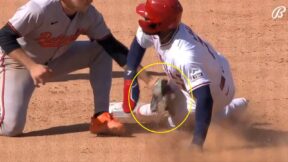Tom Seaver: Pitchers are being babied
 MLB franchises do everything they can to try to protect their top pitching prospects. The Washington Nationals did it with an innings cap on Stephen Strasburg and the New York Mets were planning to do the same with their ace, Matt Harvey. But sometimes it doesn’t work, and players like Harvey suffer a torn ulnar collateral ligament anyway.
MLB franchises do everything they can to try to protect their top pitching prospects. The Washington Nationals did it with an innings cap on Stephen Strasburg and the New York Mets were planning to do the same with their ace, Matt Harvey. But sometimes it doesn’t work, and players like Harvey suffer a torn ulnar collateral ligament anyway.
Mets pitching legend Tom Seaver believes he has a solution to the issue of so many young pitchers blowing out their arms — let them pitch more.
“Naturally, I felt terrible for (Harvey),” Seaver said, via the NY Daily News. “He’s got such a bright future. But at the same time, all I could think of was how it just goes to show how all this babying of pitchers — pitch counts and innings limits — is a bunch of nonsense. You can’t predict these things, and there’s really not a whole lot you can do to prevent them other than refining your mechanics as (’60s and ’70s Mets pitching coach) Rube (Walker) did with us. But one way I know doesn’t do anything to prevent them is babying these kids like they do.”
Seaver pointed out how the best pitchers of the 60s and 70s regularly logged 250-plus innings throughout the course of a season. Braves legend Warren Spahn threw 260 innings in 1963 when he was 42 years old.
“Take a look at all of them, Marichal, Jenkins, Spahn, what do you think made them successful?” he asked. “They conditioned their arms by pitching more, not less, starting from when they signed their first contract. Jenkins threw 300 or more innings half a dozen (actually five) times. Same with Palmer, Carlton and Marichal. I keep going back to that (July 2, 1963) Marichal-Spahn game when they both pitched 16 innings and threw almost 500 pitches between them.”
Harvey got hurt anyway. The Mets had let him pitch plenty prior to his injury, but it still happened. Seaver admitted that some injuries could simply be “genetic,” but he said putting a number on a pitcher like 100 pitches or 200 innings is ridiculous.
“There is no set numerical value you can put on a pitcher,” he said. “They’re all different. What’s important is to get into the pitcher’s head, to know what he’s made of. I guarantee most of these pitchers today would like to realize their full potential and pitch more. Unfortunately, this is what the game has come to and sadly there’s no turning back.”
From the team perspective, pitching less limits risk — especially with young arms. Yet somehow, the greatest pitchers of generations past were able to win 300 games and throw 200-plus pitches in an outing and live to tell the tale. When you take that into consideration, it’s tough not to agree with Seaver. The human body isn’t a simple math equation.







